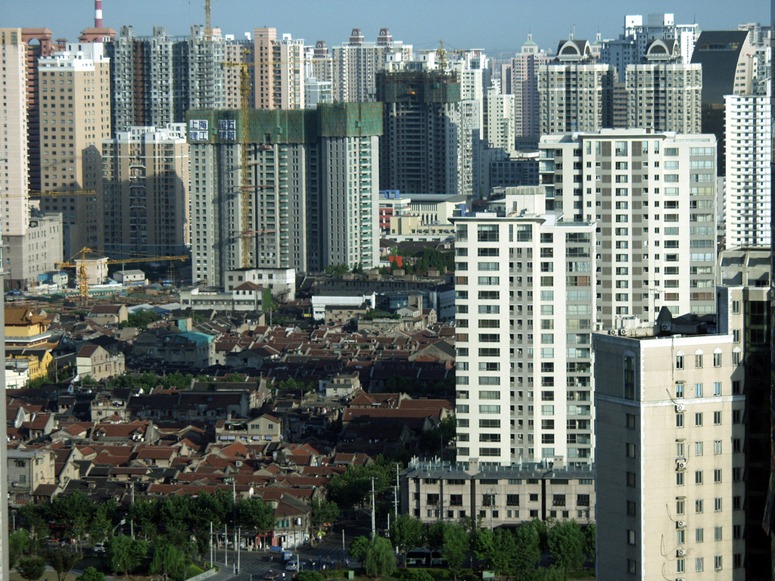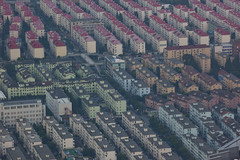If you look carefully at the pavilion-ettes on top of some of the buildings, you can tell this is a Chinese city. But I see the photograph as an illustration of the way in which context-insensitive modernist design theory is laying waste the ancient cities of China. There a surviving patch of the old city form in the foreground and glitch of marching blocks in the background. It is easy to criticise – but given the available resources, how could things have been done better? As suburban Shanghai demonstrates beyond the realms of doubt, they could certainly be a lot worse! The simplest change is that the blocks should be substantially vegetated: on roofs, balconies and walls. Shanghai is a warm wet city and this would be an adaptation to the geographical context. This policy is being adopted in a wealthy and Chinese-influenced city: Singapore.
(image courtesy leonardo_bonnani)



Where to start? With Shanghai’s strategic plan…[ http://www.richardrogers.co.uk/Asp/uploadedFiles/Image/1950_Shanghai%20Masterplan/RSHP_A_JS_1950_L_E_MP.pdf ]
Sorry, but no. The Richard Rogers Partnership plan is univeralist. It says ‘The environmentally-driven proposals were rooted in the belief that the design of cities must reflect the growing global environmental crisis and that urban designers must approach cities as places of dynamic change.’ This is vacuuous guff and I believe the firm could and would have wheeled it out (a good metaphor, given the geometry of the plan) for any city they had been asked to plan at that point in history. There is no mention (in the short summary) of Chinese history, Chinese culture or geographical aspects of the local landscape. RRP produce good architecture but have little grasp of urban design, sustainability or context-sensitivity. See my comment on their now abandonned and totally unlamented design for Chelsea Barracks in London.
TS Eliot wrote (in Murder in the Cathedral) that:
The last temptation is the greatest treason
To do the right deed for the wrong reason.
For faux-urban designers I offer the following adaptation
The last temptation is the greatest treason
To do the wrong deed for the right reason.
Put another way, Richard Rogers says the right things and does the wrong things, as do many non-environmental professionals when confronted by environmental design problems outwith their professional expertise.
HOWEVER the RRP design I see most often is for what is now called the O2 Arena on the Greenwich Peninsula. Geometrically, the great wheel-shape was an excellent response to its location on the tip of the Peninsula. But the detailed urban and landscape design of the space around the building was a typical Rogers codge-up – a space with no use and no beauty and no relationship to the site’s history. A re-design of the southern ‘frontage’ (by Whitelaw Turkington Landscape Architects) has improved things, but not enough. It would be easier to convert a main battle tank into a mobile home!
Can I can say something in defence of RRP? In their favour:
1) Always start with a plan of the site and context. It is essential to have an understanding of how the ground plane stitches together.
2) Understand how people will move in, out and through your site. There are few individuals living truly monastic and eremitical lifestyles. A site rarely exists in isolation…even if this means pulling supplies up in a basket attached to a rope….or flying in and out by helicopter or private plane.
I agree with your points and have not seen enought of his schemes to speak with any authority. But from what I have seen, and judging by the results rather than the design method, I do not regard RRP as context-sensitive designers.
This is probably true of many designers – perhaps some designs are more context sensitive than others?
My first experience of Lloyds of London was incredible. An interior designer friend advised me of the best way to experience the building and accompanied me on the visit. Her advice was:
1) Take a taxi at night to within a block of the building.
2) Get out and walk the remainder of the way.
3) As you approach the building you will start to hear a hum.
4) Then you will notice the lights.
5) The building is like a living thing within the financial district of the city.
She was right. It was awe inspiring.
[ http://z.about.com/d/architecture/1/7/T/j/lloyds.jpg ]
Could it be the case that most ‘steel and glass’ towers look better at night than during the day? I certainly think this is the case for Manhattan. It looks magically fabulous at night but walking many of the streets by day provides a depressing experience.
Strangely, this particular view (through a window of another highrise) of Manhattan by day is more appealing than its night time counterpart. See the following shot in the sequence. [ http://www.fanpop.com/spots/new-york/images/262113/title/manhattan-day ]
But then, you did say walking many of the streets didn’t you? [ http://www.city-data.com/picfilesv/picv22080.php ] It seems there is much to be said for ‘yellow’taxis!….
See Andy Goldsworthy [ http://teenangster.net/wp-content/uploads/2010/01/andy-goldsworthy-2.jpg ]
and the power of yellow…
[ http://www.royalacademy.org.uk/academicians/painters/bill-jacklin-ra,184,AR.html ]
Definitely, the Manhattan pic has ‘aesthetic quality’ – but in the terminology of the 18th century I would call it Sublime rather than Beautiful. And I think many people would rather have their cities ‘charming’ then either of these ‘artist’s’ qualities.
The Sofitel in New York is supposed to exhibit the qualities of ‘elegance’ and ‘charm’. I believe it is neither an elegant building [http://miphz.wordpress.com/2009/03/31/elegance/ ], nor a charming one [ http://www.jillcourtemanche.com/collections/bridal.php ].
I wonder, what is the existing charm of New York? [ http://paularuisidesign.com/closet.htm ]
It should be possible to combine modernity with charm – but I am having difficulty thinking of architectural or landscape examples!
How about Hong Kong….”the most dazzling place on this planet after Manhattan”?
[ http://blog.fortumo.com/2009/10/13/fortumo-unveils-the-charm-of-oriental-pearl-%E2%80%93-hong-kong/ ]
I have not been to HK but ‘fascinating’ would seem a better choice of adjective than ‘charming’. Do you think the time might come when China will be profoundly grateful to the British for having developed the city, and would it be a good idea for an African country to give a 100 year lease on an an urban site to the Chinese?
Hard to say. I am not sure what the philosophy was behind international cities? [ http://en.wikipedia.org/wiki/International_city ]
I wonder if a little modern day friendly co-operative development might not result in charming and modern and develop a incredible historical legacy?
[ http://www.undiscoveredscotland.co.uk/usbiography/monarchs/johnballiol.html ]
Berwick is culturally part of Scotland but owes much of its present form to the English. Now that these two countries have stopped fighting each other other it should be returned to Scotland, as Hong Kong was to China.
I wonder if there is more to the story of the legacy of Berwick-upon-Tweed? [ http://en.wikipedia.org/wiki/Tweed_(cloth) ] Although located on the Tweed River it does not seem to be important for its association with the cloth industry.
Its origins are as a Norse town. However, prior to Roman occupation the area was associated with the Brythons. [ http://en.wikipedia.org/wiki/Brython ]
As such, culturally perhaps it is different to Scotland as it is usually conceived. The Scots typically are said to have displaced the Picts in order to occupy Scotland. However, the shifting borders would suggest there has probably been much cultural and genetic sharing over the centuries.
Do you know anything of the custom of “specially mentioning Berwick-upon-Tweed after Wales, though abandoned in acts of parliament, is retained in certain proclamations.”?
[ http://www.1911encyclopedia.org/Berwick-upon-Tweed ]
Hi guys, I currently live/work in Shanghai and must say, I’ve been very impressed with what I’ve been seeing on a day to day basis. At first glance, there doesn’t seem to be nearly enough green spaces, but a quick walk in any direct will reveal a hidden park commemorating the local hero. As Shanghai grow denser by the day, I worry about the state of the city’s green spaces when there are many more people occupying the buildings surrounding it. Shanghai does not have the massive-scale City Parks that it should, and many of the large parks have giant lakes in them which reduce the usable land so significantly it makes me sad to think of how appropriate the land is for vegetation. Unfortunately, working in a landscape firm here, I’ve realised how difficult it is to convince a developer to pursue a project in which there isn’t a large, central, dominating lake. In fact, they come to the table with the expectation of a lake.
I take the Shanghai Metro everywhere along with miles of footsteps on the weekends, as do many, many Chinese that I see daily. Formerly having been living in Los Angeles, I think it’s a real step up from LA, where you have to drive a couple miles to take a leak. Downtown Shanghai is just about 8 miles square, so that has been the focus of my adventures, but I can’t say I’m too excited about what appear to be ugly, sprawling mid-rises city-round. But how else to accommodate the masses that head Shanghai-wards for their bread-n-butter?
I’m not sticking to the point. We need more landscape here, before we cover all the bloody land in towers.
As for the the concept of an 100-year international city lease in Africa, I’m very curious about this idea… ! This could be a very interesting idea, but I worry of the actions being done against the best interests of the locals. I grew up in Zambia [yes, yes, I’m quite international] and Chinese industries and businesses play a big role in the Zambian economy. So much so, in fact, that when Hillary Clinton went over to increase trade with Zambia at the expense of the Chinese, the government told her that their governments were very close and there would be no possibly of such a trade off. Truth be told, Zambia is the only African country I know of that trades in Renminbi (Chinese Yuan), but the current government was elected on the primary platform of controlling what Chinese businesses can and cannot do in the country, and what their role should be in the economic betterment of the locals.
As for Hong Kong, that all happened because of the Opium Wars, but the concept of allowing a rich foreign government to be sovereign to a land on a 100-year lease makes me spin with questions. A key factor would be a strategic location/resource that is of long-term value to the foreign government. Zambian copper mines? This would make Zambians incredibly angry, and possibly violent… war? Zambia would lose. — 100-year lease? Sure!
I think landscape architects have a lot of work to do in cities like Shangai. And not only in cities, but also in intermediate landscapes. I am studying a masters degree about it, and every day I think more about it.
Jonathan